Spiders are a diverse group of arachnids, belonging to the class Arachnida and the order Araneae. There are over 48,000 recognized species of spiders worldwide, inhabiting nearly every terrestrial habitat on Earth.
The realm of spiders has long been associated with a spectrum of hues, primarily featuring earth tones, blacks and browns. However, spiders can be found in colors and hues of white, yellow, blue, red, green and even pink as a testament to nature’s infinite creativity.
In this article, get to learn about spider species that exhibit a range of purple tones.
List of Purple Spiders s
- Brazilian Purple Pinktoe Tarantula (Avicularia purpurea)
- Purple-backed jumping spider (Maratus volans)
- Gooty Sapphire Tarantula (Poecilotheria Metallica)
- Chrysilla volupe (chrysilla volupe)
- Purple gold spider (Irura bidenticulata)
- Mirror Spider (Twaitesia argentiopunctata)
- Elegant Golden Jumping Spider (Chrysilla lauta)
- Hispaniolan giant tarantula (Phormictopus cancerides)
- Martinique red tree spider (Caribena versicolor)
Types of Purple Spiders
Brazilian Purple Pinktoe Tarantula

The Brazilian Purple Pinktoe Tarantula is native to the tropical rainforests of South America, particularly Brazil. This spider has a slander body that is covered in velvety hair and the entire body is in shades of purple and metallic blue.
The females grow to around 5 inches in leg span while the males are about 4 inches. Their bodies and legs have a dark purple or black base color, while their abdomens can be purple or blue.
These spiders are arboreal in nature and inhabit trees and shrubs. In their environment, they are opportunistic carnivores, preying on small invertebrates like insects, spiders and small frogs.
Like most spiders, the Brazilian Purple Pinktoe Tarantula possesses venom, but it is generally considered mild in terms of its effects on humans.
These spiders often construct intricate silk-lined burrows or builds webbing between branches, to act as retreats and hunting grounds.
Also Read: Types of White Spiders
Facts Table
| Scientific Name | Avicularia avicularia |
| Other Names | Purple tree tarantula, Ecuadorian purple tarantula, Ecuador purple pinktoe |
| How big are the females? | 5-6 inches in length |
| How big are the male? | 3-4 inches in length |
| Nature | Arboreal |
| Lifespan | 5-7 years |
| Hunting Technique | Active hunting and Ambush |
| Food | Crickets, roaches, beetles, grasshoppers, small spiders, centipedes and other arthropods. |
| Do they build webs? | YES |
| Where are they found? | Venezuela, Trinidad and Tobago, Guyana, Suriname, French Guiana, Peru, Ecuador, Colombia, and parts of the Amazon rainforest. |
Purple-backed jumping spider
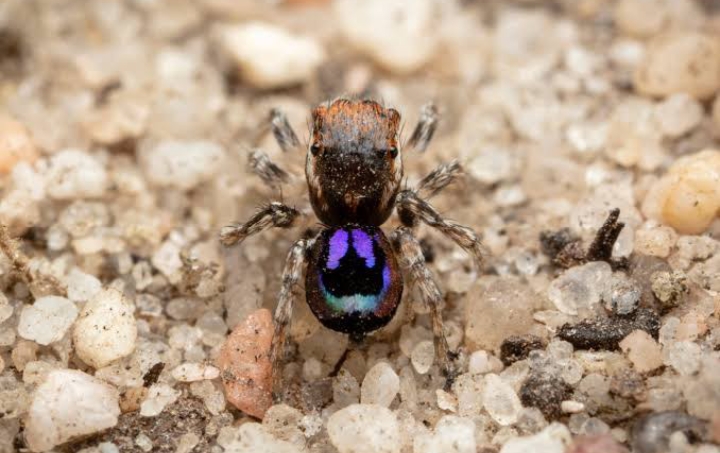
The Purple-backed jumping spider is a species of jumping spider native to Australia. It is a small spider, with a body length of about 6 millimeters. Usually, the male is about twice the size of the female.
The male has a brightly colored abdomen with a blue or purple sheen. The female is more drably colored, with a brown or gray abdomen.
During the mating season, the male performs an intricate dance to attract a female partner. This involves rapid leg movements and abdominal vibration. The male also raises its third pair of legs, displaying them in a “V” shape to show off his colors. If the female is impressed, she will mate with him.
These spiders are agile hunters, capable of leaping long distances to capture their prey, which mainly consists of small insects and other spiders. In general, the purple-backed jumping spider is not considered dangerous to humans though it possesses venom that it uses to immobilize its prey.
When hunting, the spider relies on its jumping ability to launch itself at the prey. Their powerful leg muscles being enablers of this capability.
Facts Table
| Scientific Name | Maratus volans |
| Other Names | Peacock spiders |
| How big are the females? | 3-4 millimeters in length |
| How big are the male? | Up to 6 millimeters in length |
| Habitat | Grasslands, shrublands and woodland areas |
| Lifespan | 1 year |
| Hunting Technique | Active hunting and Ambush |
| Food | Flies, beetles, ants, moths and web-building spiders. |
| Do they build webs? | NO |
| Where are they found? | Southern and eastern Australia, including parts of New South Wales, Victoria and South Australia. |
Gooty Sapphire Tarantula
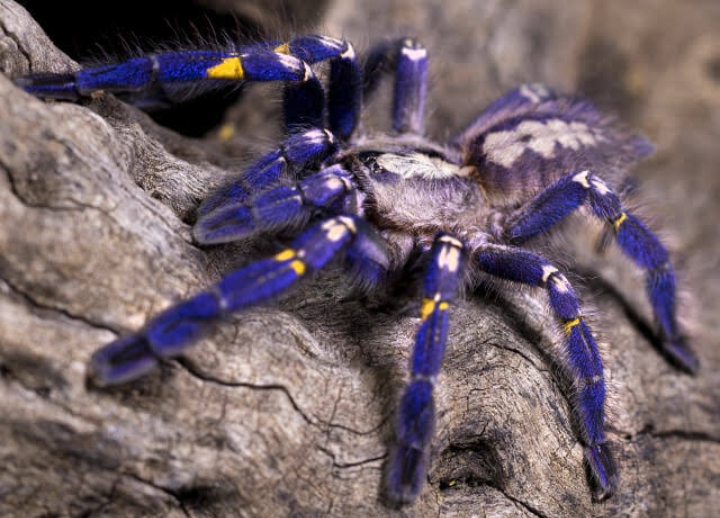
The Gooty Sapphire Tarantula, also known as the Peacock Parachute Spider or the Metallic is native to the Gooty area of the Anantapur district, in the Indian state of Andhra Pradesh. Its deep sapphire color is what gives the spider its common name, “Sapphire Tarantula” or “Gooty Sapphire Tarantula.”
The body length of this spider can be up to 5 inches. As an adult, it has a leg span of about 6 inches. Male specimens tend to have longer legs and a slimmer body compared to females.
The carapace, abdomen and legs of mature individuals are metallic blue in color. The color can be brilliant cobalt blue to a deep sapphire shade. Sometimes it might appear purple in color.
Gooty Sapphire constructs tubular burrows in the ground or use existing crevices and holes in trees for shelter. They are primarily arboreal, spending most of their time on trees. They are also known for their speed and ability to move adeptly on vertical surfaces and jump if threatened.
Like other spiders, they possess venom to subdue their prey, but their bites are usually not considered medically dangerous to humans. They diet feed on live insects, such as crickets, roaches and mealworms, beetles and small invertebrates.
According to university of Florida, The Gooty Sapphire Tarantula is listed as Critically Endangered on the IUCN Red List due to habitat loss caused by deforestation and collection for the exotic pet trade. It is protected under Indian wildlife laws, and its international trade is regulated.
Facts Table
| Scientific Name | Poecilotheria metallica |
| Other Names | Peacock Parachute Spider or the Metallic Tarantula |
| How big are the females? | 3-5 inches in length |
| How big are the male? | 2-6 inches in length |
| Habitat | Arboreal |
| Lifespan | 10 to 15 years |
| Hunting Technique | Active hunting and Ambush |
| Food | Crickets, roaches and mealworms, beetles and small invertebrates. |
| Do they build webs? | NO |
| Where are they found? | Andhra Pradesh State, India |
Also Read: Difference Between Tarantula And Spider
Chrysilla volupe
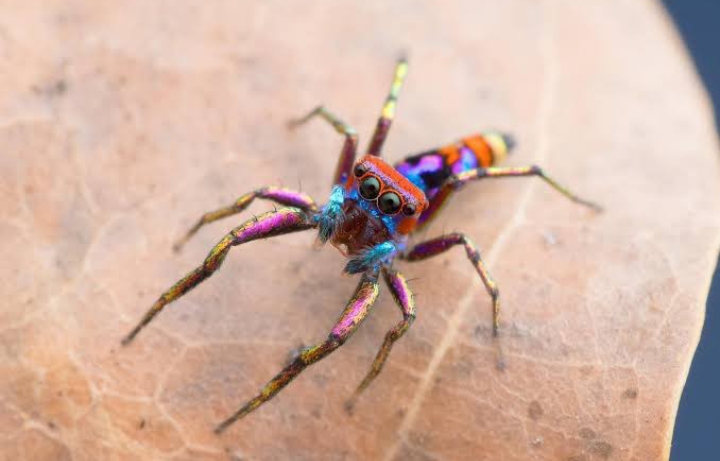
Chrysilla volupe is a species of jumping spider commonly found Sri Lanka, India, Nepal and Bhutan. This species was once believed to be extinct over 150 years ago, until it was discovered at the Wayanad Wildlife Sanctuary (WWS) in 2018.
Males have a cephalothorax in reddish orange color with two iridescent blue stripes. Legs have iridescent scales that make them appear golden and purple shades. Females have a cephalothorax that is greyish in color with grey eyebrows. All the legs of female spiders are yellow in color.
Both male and female can have a body length of about 2 inches. In their native area, they inhibit forests, grasslands and urban areas. As jumping spiders, they make precise movements in terms of impressive jumps to capture prey or escape from threats.
Chrysilla volupe spiders are active hunters with an excellent vision. Their diet consists mainly of various types of arthropods such as insects, beetles, flies, ants and other small spiders.
Facts Table
| Scientific Name | Chrysilla volupe |
| Other Names | _ |
| How big are the females? | 1-2 inches in length |
| How big are the male? | 1-2 inches in length |
| Habitat | Forests, grasslands and urban areas |
| Lifespan | 4 to 5 years |
| Hunting Technique | Active hunting and Ambush |
| Food | Insects, beetles, flies, ants and other small spiders. |
| Do they build webs? | _ |
| Where are they found? | Sri Lanka, India, Nepal and Bhutan |
Purple gold spider
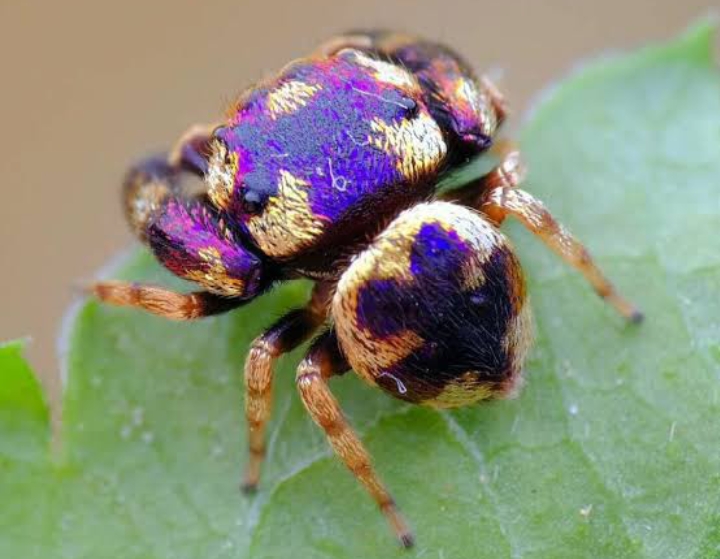
Purple-gold jumping spider was first discovered in 2011. The spider is native to regions of Southeast Asia and was first observed in Hainan, China. Subsequently, it has been found in other locations such as the Saraburi province in Thailand, Cambodia, Hong Kong, and Assam.
Females tend to have a more dull color with almost solid gold pigmentation whereas males have striking, shiny or dazzling purple-pink and gold patterned bodies.
These spiders in their native area are common in areas such as forests, grasslands and gardens. They inhabit both the lower and upper levels of vegetation like shrubs, trees and even low-lying plants. They construct small silk retreats or use natural crevices and foliage for shelter and protection.
Purple-gold jumping spider feed on small flies, mosquitoes, beetles, ants and other small spiders. Their food is mainly carnivorous, and they rely on hunting live prey rather than consuming plant matter. They stalk their prey by approaching slowly and stealthily, before launching a sudden and precise jump to capture it.
Facts Table
| Scientific Name | Irura bidenticulata |
| Other Names | Purple-gold jumping spider |
| How big are the females? | 3-4 inches in length |
| How big are the male? | 2-4 inches in length |
| Habitat | Forests, grasslands and gardens |
| Lifespan | 4 to 5 years |
| Hunting Technique | Active hunting and Ambush |
| Food | Insects, beetles, flies, ants and other small spiders. |
| Do they build webs? | NO |
| Where are they found? | Chine, Thailand, Cambodia, Hong Kong, and Assam. |
Also Read: Different Types of Green Spiders
Mirror Spider
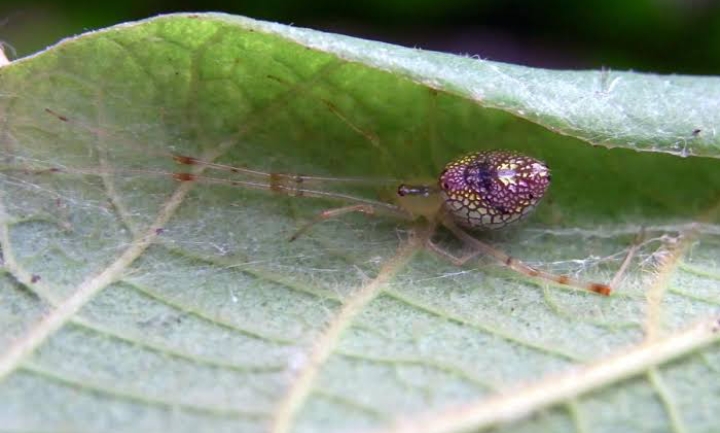
Mirror spider also referred to as the sequined spider or twin-peaked Thwaitesia is an Australian spider. Body length is around 3 mm for males, 4 mm for females. The abdomen is attractively patterned with cream, green, purple, yellow and red. This intricate pattern looks like sequins or mirrors, which is why the spider is commonly referred to as the sequined spider or mirror spider.
When the spider feels threatened or excited, it can adjust the size of the scales on its abdomen. By expanding or contracting these scales, the spider can alter the appearance of the reflective patches, potentially enhancing their visibility or making them appear less conspicuous.
In Australia, they are found in various parts of the country, almost in all regions and states. They can easily be found in forests, woodlands, grasslands and shrublands. They have also been reported in both coastal and inland regions of the country. They always select habitats that provide suitable structures for web-building.
Mirror spiders are active hunters and rely on their web to entangle and immobilize their prey. They eat small arthropods like flies, mosquitoes, beetles, ants and other small flying or crawling insects.
Also Read: Different Types of Gnats
Facts Table
| Scientific Name | Thwaitesia argentiopunctata |
| Other Names | Sequined spider or twin-peaked Thwaitesia |
| How big are the females? | 2-5 mm in length |
| How big are the male? | 3-6 mm in length |
| Habitat | Forests, grasslands and gardens |
| Lifespan | 3 to 6 years |
| Hunting Technique | Active hunting and Web building |
| Food | Flies, mosquitoes, beetles, ants and other small flying or crawling insects |
| Do they build webs? | YES |
| Where are they found? | Australia |
Elegant Golden Jumping Spider
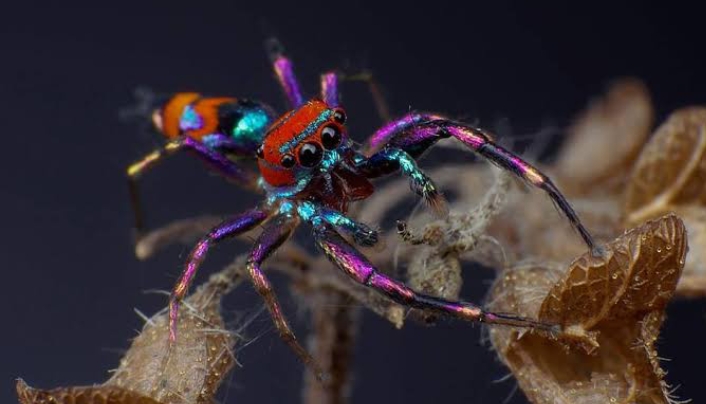
The Elegant Golden Jumping Spider, as its name suggests, its body has golden coloration and in general the spider has a graceful jumping ability. It is found rain forests of Burma to China and Vietnam, Thailand, Malaysia and Indonesia.
Their bodies are elongated and flattened. Adult females measure around 1 to 2 inches length, while males are slightly smaller, about 1 to 1.5 inches. The cephalothorax of this spider is purple-blue with a narrow purple and orange stripes. The legs can have purple or blue stripes, occasionally with golden blush.
Elegant Golden Jumping Spider, like other members of the jumping spider family, has eight eyes arranged in two rows on the front of its cephalothorax. Their eyes provide them with acute vision and depth perception
Within their habitat, they can easily be spotted on plants, leaves, flowers, and tree trunks, where they hunt for prey and seek shelter.
Rather than building webs to capture prey, they rely on their excellent vision and agility to stalk and pounce on their prey. Their prey are insects such as flies, beetles, ants, moths and small grasshoppers. They also eat other small arthropods like mites, springtails and small crustaceans.
Facts Table
| Scientific Name | Chrysilla lauta |
| Other Names | _ |
| How big are the females? | 1-2 inches in length |
| How big are the male? | 1-1.5 inches in length |
| Habitat | Vegetation |
| Lifespan | 4 to 5 years |
| Hunting Technique | Active hunting and Web building |
| Food | Flies, beetles, ants, moths and small grasshoppers, mites, springtails and small crustaceans. |
| Do they build webs? | YES |
| Where are they found? | Asia (Burma, China, Vietnam, Thailand, Malaysia and Indonesia). |
The Hispaniolan giant tarantula

The Hispaniolan giant tarantula is native to the island of Hispaniola in the Caribbean, which includes the countries of Haiti and the Dominican Republic. The color of this spiders can vary among individuals, but it usually consists of a combination of dark brown, purplish-black and brown hues. Their abdomen has intricate geometric shapes and markings.
They spend their days in burrows or natural crevices, which they construct or find in the ground. They only come out at night to look for prey. Their fangs are quite strong. They are used to pierce the body of its prey and to inject venom. While their venom can cause discomfort and pain, it is generally not dangerous.
They feed on insects like crickets, beetles and grasshoppers, but they can also capture and eat small lizards and small frogs.
These spiders are terrestrial in nature. They dwell on the ground rather than climbing trees or other vertical surfaces. They inhabit habitats such forests, savannas and grasslands, found throughout the Hispaniola.
When threatened, they exhibit defensive behavior like rearing up on their hind legs and displaying their fangs or rubbing hairs from their abdomen, which can cause irritation and discomfort if they come into contact with the eyes or skin of potential predators.
Facts Table
| Scientific Name | Phormictopus cancerides |
| Other Names | Hispaniolan giant tarantula |
| How big are the females? | 3-4 inches in length |
| How big are the male? | 1-3 inches in length |
| Habitat | Vegetation |
| Lifespan | 6 to 8 years |
| Hunting Technique | Active hunting |
| Food | Crickets, beetles, grasshoppers, small lizards and small frogs |
| Do they build webs? | NO |
| Where are they found? | Island of Hispaniola in the Caribbean, which includes the countries of Haiti and the Dominican Republic. |
Martinique red tree spider
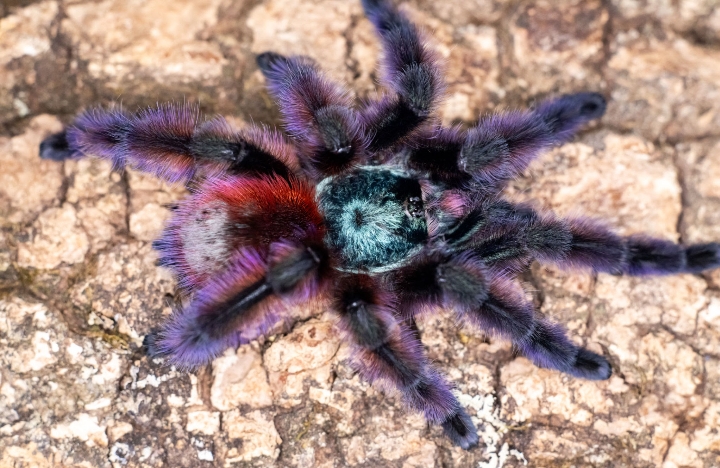
The Martinique red tree spider is native to the Caribbean Island of Martinique. It is an arboreal species and only inhabits trees and other elevated locations. The male species is usually smaller and slender when compared to females.
The young spiders have a deep-purple or blue color, while adults display a mixture of red, purple, blue and brown hue with red or purple hairs covering some parts of the body. Males usually are slightly more brightly colored than females.
Adults have a leg span of about 3 to 5 inches and a body length of around 2 inches. The spiders are skilled climbers and construct silk-lined burrows in tree trunks, under bark or in tree hollows. They are most active during the night. During the day, they retreat to their burrows or hide within crevices.
Martinique red tree spider is an opportunistic hunter. It feeds on insects and small arthropods. Like most arboreal spiders, they capture their prey by ambushing or waiting near their burrows for prey to pass by.
Facts Table
| Scientific Name | Caribena versicolor |
| Other Names | Martinique red tree spider |
| How big are the females? | 3-4 inches in length |
| How big are the male? | 2-3 inches in length |
| Habitat | Forests and Vegetation |
| Lifespan | 10 to 12 years |
| Hunting Technique | Active Hunting and Ambush |
| Food | Crickets, beetles, grasshoppers, flies, small lizards and frogs. |
| Do they build webs? | NO |
| Where are they found? | Caribbean Island of Martinique |